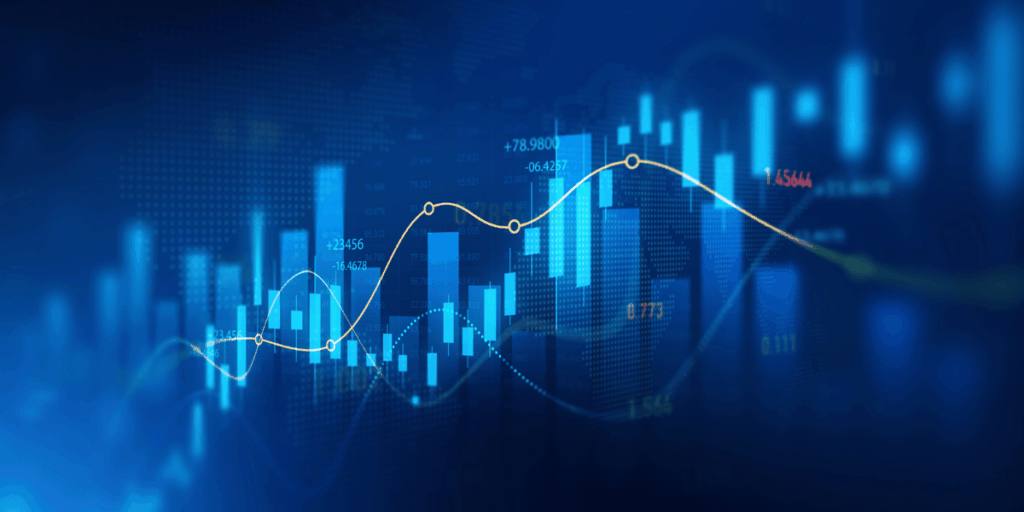For those of you who would prefer to listen:
Changing direction is a normal course of action in life. It’s usually driven by new information obtained. Either the facts changed, or perhaps you were wrong. It’s an important function on the road to success. You can’t keep going in the wrong direction and the sooner you recognize it, the probability of better outcomes grows. Good strategies have a plan A and plan B. And here’s a fact: Most people don’t like to admit when they’re wrong, even though most of the time everyone knows it. Of course, some are better at this than others.
Stating the obvious, there’ve been a number of U-turns out of the White House of late. They haven’t been the smooth and gradual kind either. It’s been more of a slam the brakes and flip the wheel in an instant kind of turn. Those tend to be startling and gut-wrenching. The whipsaw price action in the Stock Market reflects it.
The Market has started looking through the rhetoric coming out of the Oval Office. The tough talk on trade with China and comments about firing the Fed head sent prices of American assets south, and fast. It was putting serious stress on the Financial System. That’s where the U-turn came.
There’s been constant contradiction inside the Oval Office. Trade advisors Peter Navarro and Howard Lutnick were noticeably quiet this week. They’re the hardliners in the cabinet. Treasury Secretary Bessent has been more pragmatic. Bessent seems to be the most trusted voice in the White House. The Market likes that.
The Treasury Secretary told a closed-door summit this week that the current situation was unsustainable and a de-escalation with China was likely. That reversed the stock selling and triggered a rally. It accelerated when the President switched gears and said he won’t fire Fed Chair Powell. As a reminder, Trump launched multiple attacks on Powell last week for not cutting rates and said his termination cannot come fast enough. He also called him a “loser”. You read that right. This activity caused turmoil in the Bond Market which has been a larger driver of stock prices of late. A major crisis was brewing. It wasn’t a complete U-turn, as the President plans to keep pressuring the Fed to cut rates. But Powell’s job is safe, for now. The Bond Market wins again. That immediately took the boil off the brew.
President Trump signaled that tariffs on China will come down substantially if the two sides reach an agreement. That said, he made it clear they won’t go to zero. He also said he would be “very nice” in talks with Beijing with no reason to employ hardball tactics. That caught some headlines, considering he campaigned on playing hardball with China, and has done it even bigger than imagined thus far. Keep in mind, being tough on China is one thing that has bipartisan support. But it’s also clear that a Trade War will hurt everyone. China has said it is willing to discuss tariffs with the US but not under duress.
America is the largest consuming nation on the planet, and it’s not even close. China exports $440 Billion of goods to the United States. Conversely, they buy just $140 Billion from America. That leaves the trade deficit at $300 Billion. Pretty simple math. Tariffs on Chinese imports are currently at 145%. What China does buy is a lot of agriculture. Pork and soybeans top the list. Chinese pork imports fell 72% this week. American farmers are feeling the heat.
The White House said it’s considering cutting tariffs on Chinese imports by up to half in some cases in an effort to de-escalate China trade tensions. On other fronts, discussions have reportedly been quite productive with India, Japan, South Korea and Vietnam. It’s moving the needle on deals. As it pertains to China, it remains confusing with contradiction. The President said trade talks with China are ongoing. Beijing said succinctly, they’re not. Sounds like there’s a lot of talking about talking, but still little actually happening. I suppose it’s better to talk about talking than not talk about talking. What does seem clear, the draconian measures on trade outlined a couple of weeks ago appear to be vanishing. That’s most likely what the Market is interpreting. That has ignited this rally.
Make no mistake, the US Economy was already slowing. Some of the data still looks solid. But it’s mostly in the rearview mirror. There is clear evidence of front-loading ahead of the tariff implementations. Last week we saw a large increase in car purchases within the March Retail Sales. This week, we saw durable goods orders jumped 9%. These are defined as items that are not immediately consumed. They have longer utility periods. Importantly, just 1.5% growth was expected. Transportation equipment was again the driver, up a whopping 27% from the previous month. People have been buying cars before prices jumped. The sector is clearly caught in the crossfire of the trade war.
The evidence of the trade war is about to arrive on the shores of the Pacific. More accurately, it’s what’s not going to arrive. The ports in Long Beach and Los Angeles expect a 44% decline in cargo ships for the first week of May. The vast majority of its items come from Asia. The sudden drop in shipping activity to the US presents a serious challenge for American companies. There’s been little time to reorganize supply chains. Apple said it plans to manufacture most of its iPhones for the US in India by the end of next year, accelerating its shift away from China. The goal means Apple will need to roughly double its iPhone output in India. The thing is, most American companies don’t have the ability nor resources to move like the Titan of Cupertino. It’s a problem.
Corporate America is really nervous about the impact of these tariffs on consumer spending. Pepsi, Chipotle, and Proctor & Gamble all missed earnings expectations and lowered guidance for the year. This was not unexpected. P&G said the proposed tariffs could add $1.5 Billion in costs. Skechers flat-out pulled its guidance for 2025, citing too much uncertainty. Their stocks had already been weak, pricing in the slowdown. The Market is good at anticipation.
The airlines have been calling out the weakness for weeks. American and Alaska said what United and Delta already did. Traffic is slowing. Southwest’s CEO said he has not seen traffic fall this fast, absent September 11th and Covid. Now that’s saying something.
Corporate America finally pushed back on the Trade War pressures. CEOs of our nation’s largest Retailers, Aerospace & Defense and Car Companies were in Washington this week spelling out the damage that could occur if the White House continued down this path. It worked. The hardline talks on trade softened significantly. The Market responded favorably.
On the positive side: Google reported a strong quarter and had some insightful things to say. It was the first of the Tech Titans to go. Google Cloud business continued to grow at a strong clip, up 28%, ahead of expectations. Search grew 10%, which is key as it transitions to the AI world. Another key read-through was advertising. It’s one of the first things companies cut when they’re nervous about the future. That’s no surprise. Ad revenues for Google continued to grow, indicating that the slowdown has not yet hit Google. Equally important, the company raised its dividend and authorized a $70 Billion stock buyback program. Companies don’t usually do that if they’re not confident in the outlook. This company, like most in Silicon Valley, has sights well beyond the now.
Move over Mag 7. The Bond Market is the boss these days. It’s been dictating moves more than anything. The Treasury Department had another busy week of auctions with mixed results. It sold $70 Billion of 5-year notes and $69 Billion of 2-Year maturities and $44 Billion of 7-year. America keeps borrowing, which is still a big issue. The good news is investors still want our debt. Interestingly, demand was strongest further out on the curve. That’s a good sign for confidence in the future, a few years out.
There’s been what’s called a “Bull flattening” of the Yield Curve. Treasury prices have started going up again. That has yields going down. And importantly, it’s most pronounced on the back-end of the curve. The 10-Year has backed off that 4.5% level which was choking off the financial system. 30s have backed off 5%. The 2-Year yield, sitting near the front end of the curve, has been stuck around 3.7%. It’s anticipating Fed cuts ahead. As is always the case in Bond Land, lower yields mean higher prices. It’s a mathematical relationship between the two. Equally important, the Dollar reversed its slide. Demand for American assets nearly evaporated amidst the chaos. It returned this week. Investors bought America’s assets again.
Global investors were overweight US assets heading into 2025. It’s actually been the case for years. It is estimated that foreign investors own $19 Trillion of US equities, $7 Trillion of US Treasuries and $5 Trillion of US Corporate Bonds. That accounts for roughly 25% of the Total Market. Investors coveted American Stocks and Bonds and Dollars. That reversed hard this year. Seeing all 3 decline simultaneously is beyond unusual. It really spoke to this environment.
Investors, both at home and abroad, are accustomed to getting a lower return due to the safety and stability of U.S. Treasuries. The changing and chaotic policies coming out of Washington threaten that long-standing norm. Treasuries are considered hedges against risky assets. For much of this year, they’ve traded like they were the risky assets. Money seeking safety bypassed Treasuries and fueled the explosive rise in Gold. That reversed quite a bit this week. But consequences come with costs. America has over $36 Trillion in debt. And the confusion out of the White House has shaken confidence and stability. Congress has been kicking the can down the road for years on the mountain of debt. The cost to service said debt has ballooned. Something’s gotta give. We are in fact running out of road.
Outside of that historic date, which sent the S&P up 9% after the White House put a pause on tariffs, there had not been much in the way of further progress for stocks. There certainly was this week. It saw back-to-back daily moves that brought over 9 to 1 advancers to decliners. The week ended with 4-consecutive gainers. Participation was broad. 98% of the S&P 500 stocks were higher. All 11 sectors were green.
We’ve been looking for a clustering of rallies, rather than the single, explosive days. Forward progress with reduced volatility can be a signal that bottom formation is developing. Higher lows help. That’s what we’re seeing. The sell-off early in the week found footing around 5,100 on the S&P. That’s a material distance from the early April lows of 4,800. It’s also a material move higher in a short period of time. We saw some resistance around this 5,500 level. That translates to roughly Dow 40K. It’s a natural place to take a breather. It’s the halfway point between the all-time highs reached in February and the cycle lows touched this month. It’s also the level it pinged around at in March, before the bottom dropped out.
Will this recovery last? Of course we don’t know. This has been a major test. The Global Economy has been tested. Our alliances have been tested. Every institution has been tested. Investor mettle has certainly been tested. Fortunately, nothing has broken; At least not yet. But trust and confidence has absolutely been strained, which will take time and authentic effort to heal. We continue to use the Market as our guide. The Bond Market is the North Star for financial assets. The message we interpret is, a crisis has been averted. China and the United States were on a collision course in a trade war. Brakes have been applied.
Signals are getting louder for some deal-making. That’s inherently a good thing. Or perhaps, as I often say, less bad. The road to success is never a straight line. But it shouldn’t have this many U-turns either. To be clear, there’s been no all-clear sign. There’s still a ton of uncertainties that should keep the volatility around awhile longer. And of course, we suspect there will be a few more U-turns too. But this we know: Cooler heads prevail. We’re staying cool. Well, you know, as cool as Market Geeks can be. We also know, slow and steady wins the race. We’re hanging in just fine.
Have a nice weekend. We’ll be back, dark and early on Monday.
Mike






